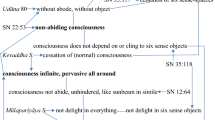Conclusion
To explain the khandhas as the Buddhist analysis of man, as has been the tendency of contemporary scholars, may not be incorrect as far as it goes, yet it is to fix upon one facet of the treatment of the khandhas at the expense of others. Thus A. B. Keith could write, “By a division which ... has certainly no merit, logical or psychological, the individual is divided into five aggregates or groups.” However, the five khandhas, as treated in the nikāyas and early abhidhamma, do not exactly take on the character of a formal theory of the nature of man. The concern is not so much the presentation of an analysis of man as object, but rather the understanding of the nature of conditioned existence from the point of view of the experiencing subject. Thus at the most general level rūpa, vedanā, sañña, and are presented as five aspects of an individual being's experience of the world; each khandha is seen as representing a complex class of phenomena that is continuously arising and falling away in response to processes of consciousness based on the six spheres of sense. They thus become the five upādānakkhandhas, encompassing both grasping and all that is grasped. As the upādānakkhandhas these five classes of states acquire a momentum, and continue to manifest and come together at the level of individual being from one existence to the next. For any given individual there are, then, only these five upādānakkhandhas — they define the limits of his world, they are his world. This subjective orientation of the khandhas seems to arise out of the simple fact that, for the nikāyas, this is how the world is experienced; that is to say, it is not seen primarily as having metaphysical significance.
Accounts of experience and the phenomena of existence are complex in the early Buddhist texts; the subject is one that is tackled from different angles and perspectives. The treatment of rūpa, vedanā, saññā, and represents one perspective, the treatment of the six spheres of sense is another. As we have seen, in the nikāya formulae the two merge, complementing each other in the task of exposing the complex network of conditions that is, for the nikāyas, existence. In the early abhidhamma texts khandha, āyatana and dhātu equally become complementary methods of analysing, in detail, the nature of conditioned existence.
The approach adopted above has been to consider the treatment of the five khandhas in the nikāyas and early abhidhamma texts as a more or less coherent whole. This has incidentally revealed something of the underlying structure and dynamic of early Buddhist teaching — an aspect of the texts that has not, it seems, either been clearly appreciated or properly understood, and one that warrants further consideration.
Similar content being viewed by others
Author information
Authors and Affiliations
Rights and permissions
About this article
Cite this article
Gethin, R. The five khandhas: Their theatment in the nikāyas and early abhidhamma. J Indian Philos 14, 35–53 (1986). https://doi.org/10.1007/BF00165825
Issue Date:
DOI: https://doi.org/10.1007/BF00165825



